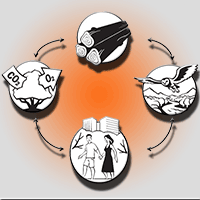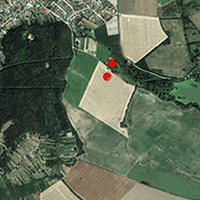
Payment for forest environmental services: a meta-analysis of successful elements
iForest - Biogeosciences and Forestry, Volume 6, Issue 3, Pages 141-149 (2013)
doi: https://doi.org/10.3832/ifor0707-006
Published: Apr 08, 2013 - Copyright © 2013 SISEF
Review Papers
Abstract
Forest ecosystems produce environmental services from which individuals benefit. In recent decades, interest in these services has significantly increased to meet the demand for new products and services related to landscape use and recreational activities. These new products and services are defined as Non-Wood Forest Products and Services (NWFP&Ss). There is the possibility, and in certain cases the need, to introduce a system of payment for these NWFP&Ss. However, the transformation of forest environmental goods and services into commercial products and services is not a straightforward process. This paper reviews a number of successful payment mechanisms for NWFP&Ss in order to examine the elements which contribute to transforming these externalities into sources of income for people living near forests.
Keywords
Payment For Environmental Services (PES), Forest Resources, Non-wood Forest Products And Services, Landscape, Tourism
Authors’ Info
Corresponding author
Paper Info
Citation
Gios G, Rizio D (2013). Payment for forest environmental services: a meta-analysis of successful elements. iForest 6: 141-149. - doi: 10.3832/ifor0707-006
Academic Editor
Marco Borghetti
Paper history
Received: Jul 27, 2012
Accepted: Jan 09, 2013
First online: Apr 08, 2013
Publication Date: Jun 01, 2013
Publication Time: 2.97 months
Copyright Information
© SISEF - The Italian Society of Silviculture and Forest Ecology 2013
Open Access
This article is distributed under the terms of the Creative Commons Attribution-Non Commercial 4.0 International (https://creativecommons.org/licenses/by-nc/4.0/), which permits unrestricted use, distribution, and reproduction in any medium, provided you give appropriate credit to the original author(s) and the source, provide a link to the Creative Commons license, and indicate if changes were made.
Web Metrics
Breakdown by View Type
Article Usage
Total Article Views: 63223
(from publication date up to now)
Breakdown by View Type
HTML Page Views: 53218
Abstract Page Views: 3331
PDF Downloads: 4868
Citation/Reference Downloads: 80
XML Downloads: 1726
Web Metrics
Days since publication: 4634
Overall contacts: 63223
Avg. contacts per week: 95.50
Citation Metrics
Article Citations
Article citations are based on data periodically collected from the Clarivate Web of Science web site
(last update: Mar 2025)
Total number of cites (since 2013): 8
Average cites per year: 0.62
Publication Metrics
by Dimensions ©
Articles citing this article
List of the papers citing this article based on CrossRef Cited-by.
References
L’evoluzione del concetto di lusso e la gestione strategica della marca. Un’analisi qualitativa delle percezioni sul concetto, sulla marca e su prodotto di lusso. Congresso Internazionale: “Le tendenze del marketing”. Università Cà Foscari (Venezia, Italy) 20-21 Jan 2006.
Gscholar
Stato d’attuazione della pianificazione assestamentale (di gestione forestale a livello aziendale) nella regione Emilia Romagna. Sherwood 6 (3): 5-8.
Gscholar
Land for the future. Johns Hopkins University Press, Baltimore, USA.
Gscholar
Measuring environmental amenity benefits of agricultural land.
Gscholar
Sustainable forest management at the local scale: a comparative analysis of community forests and domestic forests in Cameroon. Small-scale Forestry 1-16.
Gscholar
Millennium ecosystem assessment, ecosystems and human well-being: a framework for assessment. Island Press, Washington, DC, USA, pp. 1-25.
Gscholar
Heterogeneity and collective action for forest management. Research Paper 2011/02, Human Development, UNEP.
Gscholar
Entrepreneurship in the forest sector in Europe, University of Joensuu, Faculty of Forestry, Silva Carelica 52.
Gscholar
The role of networks in non-wood forest products and services marketing in Europe. In: “Modeling, Valuing and Managing Mediterranean Forest Ecosystems for Non-Timber Goods and Services” (Palahi M, Birot Y, Bravo F, Gorriz E eds). EFI Proceedings No. 57, pp. 143-156.
Online | Gscholar
Small-scale forestry in the Italian Alps: from mass market to territorial marketing. In: Proceedings of IUFRO 3.08 Conference “Small-scale forestry and rural development: the intersection of ecosystems, economics and society” (Wall S ed). Galway-Mayo Institute of Technology, Galway (Ireland) 18-23 June 2006. COFORD, Dublin, Ireland, pp. 398-408.
Gscholar
Il ruolo della selvicoltura nella gestione faunistica. Sherwood 112: 19-23.
Gscholar
Principles for fairness and efficiency in enhancing environmental services in Asia: payments, compensation, or co-investment? Ecology and Society 15 (4): 17.
Gscholar
Innovazioni turistico-ricreative nel bosco: comparazione tra Austria e Italia. Dendronatura 30(2): 10-16.
Gscholar
Sustainable development in a dynamic world transforming institution, growth and quality of life. World Bank and Oxford University Press, Washington, DC, USA.
Gscholar
Payments for environmental services: some nuts and bolts. Occasional paper No. 42, CIFOR, Bogor, Indonesia.
Gscholar
Legno di risonanza Gestione, selezione e lavorazione nelle Foreste Demaniali di Paneveggio (TN). Sherwood 155: 14-18.
Gscholar

















